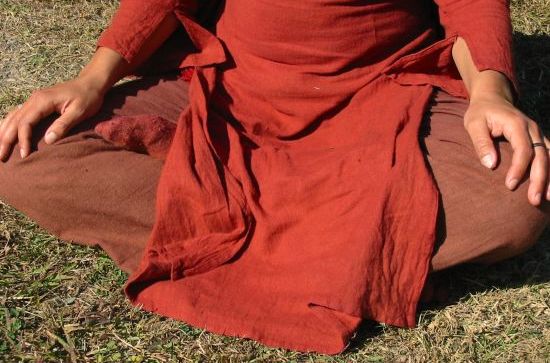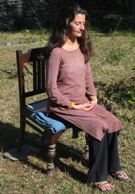
The Buddha said meditation flows through all “four postures” of walking, standing, sitting and lying down. The sage Patanjali defined good meditation posture as the position in which you can happily stay still and steady. Notice how striving to find an imaginary perfect posture is just a nagging, unpleasant, mind-game. Experiment with different positions, especially if you struggle with pain during much of the session, or if pain persists after you move out of your chosen posture. It is not necessary to use the same position in every session.
With acceptance of the body and mind as they are in the moment, an ease and stillness can begin to develop.
Reclining Posture
For many people, lying down is the position most suitable for being relaxed, open and still. This relaxed stillness makes it harder for the controlling mind to dominate and therefore leaves space for a deeper and more fluid awareness to come through.
You will need a soft, flat surface to lie on. Usually a yoga mat is too thin if you want to be able to stay still long enough for a deep meditation. Use a mattress, folded blanket, soft carpet, or a combination of two or more things.
You may also need extra cushions or some improvised substitute, such as a folded sweater or blanket.
It is really worthwhile to experiment with different degrees of softness and different heights of cushions and surfaces. A centimeter of adjustment can make all the difference.
click to see or download a poster with diferent reclining postures.
~ Lying on your back
Make sure you are lying on a soft enough surface and preferably with no extra pillow under your head. Put pillows under your knees to protect your back. Even better for many people is to place pillows under the whole length of your legs, with the feet higher than the knees and the knees higher than the hips. Be careful with your knees: if the legs roll out to the sides too much, they may feel strained.
~ Lying on your side
With your hips and knees bent and your arms comfortable, lie on your side with pillows under your head and between your knees/legs.
You might notice a difference between lying on your left or your right side.
See hand suggestions for hand positions.
~ Lying turned 3/4ths of the way towards the floor or bed
If you start by lying on your side, you can shift towards the floor or bed, and straighten one leg. Usually a very small, soft pillow under your ear is enough, but be caring about your neck. Some people prefer this position without a pillow under the head, and others prefer to put a larger pillow under the whole upper body. You may also like to put one hand under the hip of your straight leg, and the other near your forehead, face, throat or upper chest.
~Lying on the belly
Lie face down with both legs straight, and perhaps palms face up under the hips. Your head will need to tilt slightly to one side, and a soft pillow under the ear may suffice.
Hands
Where you place your hands is up to you. It can make a big difference where your hands are, and what they are touching. Some people need to have the hands not touching the body; others find certain hand positions helpful for meditation.
In many postures, we can let the hands find their place and even let them help harmonize body, heart, mind and spirit.
We can also play with some Jin Shin Jyutsu as part of meditation posture. (For more on Jin Shin, click here.) Try holding one or more fingers on one hand with the other hand.
If lying on your back, you can place your hands:
~ On the hips.
~ On the base of your ribcage.
~ On the upper chest.
If you want to place your hands on the upper chest, support your bent elbows with soft pillows, although the arms may still tend to fall asleep after 20 minutes or so.
If lying on your side, you can place your hands:
~ On the knees. You can place your lower hand between your knees and the upper hand on top of the upper outer knee.
~ On the neck and hip. With the lower arm bent, place your fingers on the middle of your neck. At the same time, you can place your upper arm along your hip and buttock, so that the fingers are near the coccyx.
~ On the cheek and collarbone. Invent a comfortable way for you to place one hand on one cheek and the other hand on the collar bone of the same side of the body as the cheek.
Sitting Posture
Hands rest comfortably on knees or lap. Chest is open, with shoulders relaxed down and back. Chin is slightly tucked in, allowing the neck to be straighter than usual. Top of hips is slightly rolled forward, so that abdomen opens and spine is supported and straight. Angling the cushion or the seat of the chair can help hips to tilt forward. If sitting on cushions, experiment to find the best height. Some people need to sit directly on the floor without a cushion, and some people need several cushions stacked up.
Sitting in a chair:
With feet resting firmly on floor or cushions, sit upright and without leaning on the back of the chair if possible. Propping the back two legs of the chair up on small supports helps hips roll forward, and keeps the front edge of the chair from cutting off circulation through the backs of the legs.
Sitting on the floor:
"Japanese style" ~ Kneel with the buttocks resting on a cushion or bench. Make sure not to put too much weight on the knees.
![]()
"Thai" or "Sri Lankan style" ~ Sit on cushion or floor, and bend one leg across the front with the knee pointing out to the side. Bend the other leg to one side so that the knee points to the front and the foot points behind you. As with other cross-legged positions, please alternate legs in alternate sittings: if the left leg is in front in one sitting, then have the right leg in front in the next sitting.
"Burmese style" ~ Bend both legs, with knees pointing out to the sides, and with both lower legs and feet resting on the floor, one in front of the other. Alternate which leg is in front, if possible.
"Lotus style" ~ Same as "Burmese" but with one or both feet and lower legs crossed on top of the opposite calf or thigh.







